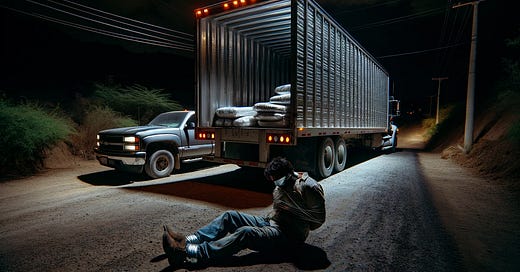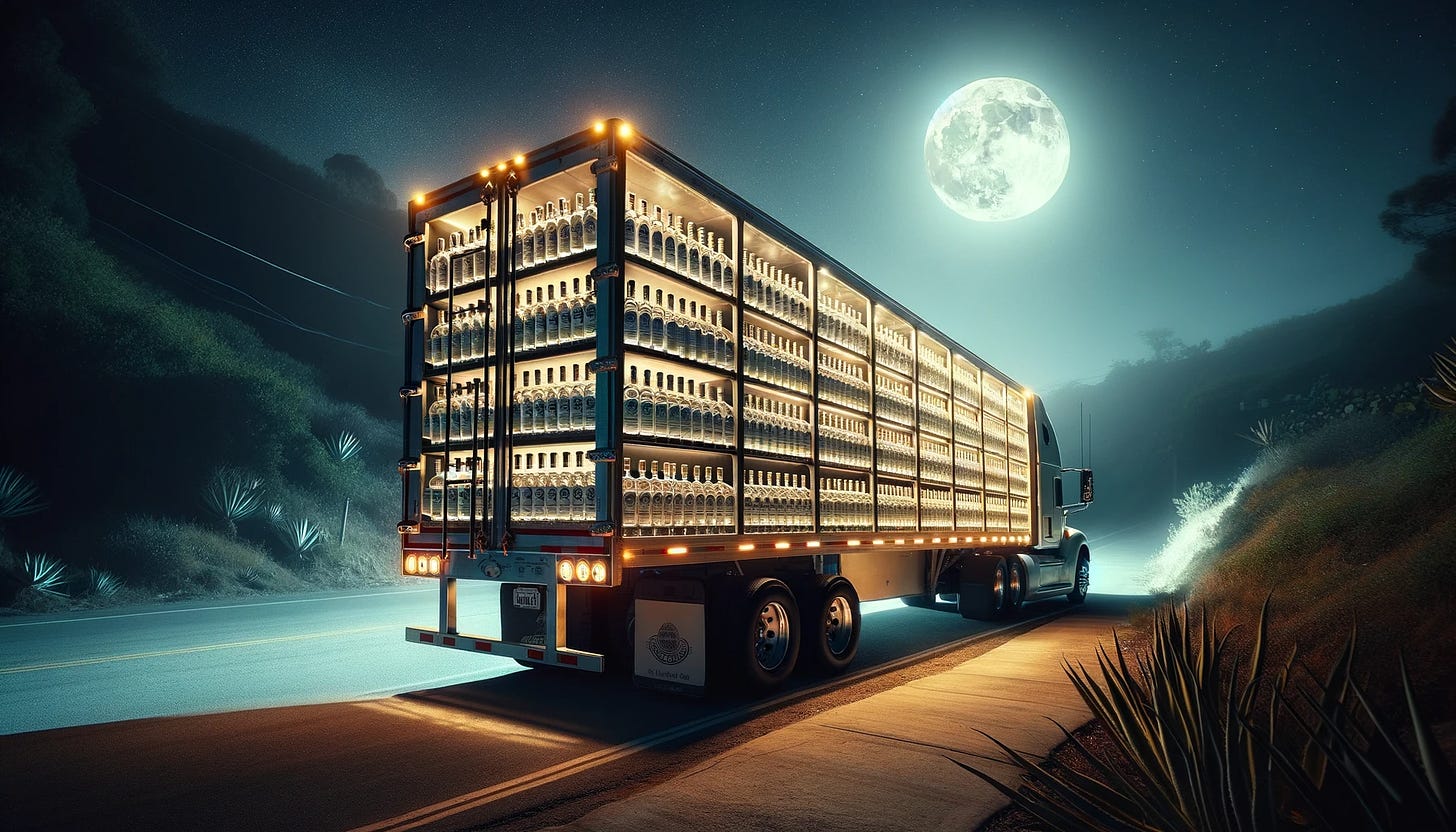Issue #8: Security in Mexico
Cargo theft is one of the hottest topics in cross-border logistics. It's less daunting than it feels.
Let’s get technical again and talk about all things security in Mexico. It’s been one of the more consistent themes that I’ve seen in my nearly ten years of involvement in cross-border freight – every shipper is worried about their freight being stolen in Mexico.
First, let’s start with a jaw-dropping fact: freight brokers and trucking companies are not liable for the freight while it’s in Mexico. The amount you can claim against a provider is equal to about $2,000 for a truckload, whether it’s worth $100k or $250k.
According to Reliance Partners’s Mexico Cargo Hijacking Data Portal, 6,030 loads were hijacked from January 2023 to September 2023, an 8% increase from the same time period in 2022. Only 1% of those hijackings occur in the Mexican states that border the United States. 85.5% of the hijackings took place in three states: Estado de Mexico, Puebla, and Michoacan.
What kind of freight gets stolen in Mexico?
Criminals in Mexico target the type of freight that can easily be sold on the black market. In some cases, drivers will be pulled over, have the product stolen or broken into, but they’ll be able to keep their truck. In other cases, the truck, trailer, and product are all stolen. Interestingly, I’ve heard of carriers who eventually get their equipment back, but it takes working through some intermediaries to try and recover it.
Some common products that are known to be targeted:
Appliances
Electronics
Tires
Tequila and mezcal
Food and groceries
Construction materials
Most major appliance, electronics, and tire manufacturers have plants in Mexico. A lot of construction material companies have products coming out of Mexico, including flooring, doors, windows, and other core materials. And tequila, mezcal, and a lot of food products are produced in Mexico and can easily be resold within Mexico.
Every shipment carries a level of risk of theft in Mexico and it’s something that factors into the type of freight a carrier will haul, and where a manufacturer should consider setting up shop if still in the early stages of establishing its nearshoring strategy. This risk is one of the drivers behind the heavy investments in markets close to or located at the border, like Monterrey, Reynosa, Matamoros, Juarez, Chihuahua, Mexicali, and Tijuana. Aside from Monterrey (155mi from Laredo) and Chihuahua (235mi from El Paso), the rest of those cities are located on the Mexican side of the border.
How do you improve security and reduce the risk of theft in Mexico?
Just like everything else in logistics, there isn’t a single silver bullet that solves all the theft issues in Mexico. It takes a combination of strong SOPs, quality cross-border partners, and some better protections in certain aspects of the process.
Insurance: freight brokers and trucking companies are not required to insure the freight while it’s in Mexico, which is very different from how it works in the United States or Canada. It is on the beneficial cargo owner to buy coverage on the freight if they need it insured. This is where shippers and brokers will partner up with someone like Mark Vickers at Reliance Partners. He leads their Borderless Coverage program that provides customer-specific coverage in Mexico for damage and theft.
CTPAT Suppliers: Companies who manufacture in Mexico will benefit from better security protocols that are followed within CTPAT-certified facilities and carriers. Generally, these security requirements also satisfy the requirements that Borderless Coverage needs to provide insurance in Mexico. See below for a deeper definition of CTPAT and a related program, AEO/OEA.
Tracking: Understanding where the freight is from pickup to the border is absolutely critical. You may get that visibility working with a freight brokerage or 3PL, or by leveraging GPS links for tracking, or using a tracking device like Tive. Knowing where the freight is at all times will provide a better sense of security, although it can still get hijacked and disappear at any moment.
CTPAT: CTPAT stands for Customs Trade Partnership Against Terrorism. It’s a security program that’s overseen by U.S. Customs and Border Protection (CBP). It was created in November 2001, after the 9/11 terrorist attacks, by the U.S. government as a way to improve security for the United States, including tightening up security within North American supply chains.
Most freight brokers, given that they’re non-asset based, don’t have CTPAT certification. Facilities shipping to the United States and the carriers who haul that freight, along with facilities that manage it at the border, are required to be CTPAT-certified if the manufacturer wants to maintain their CTPAT certification. It allows all parties involved in the process to keep our supply chains more secure.
The CTPAT program entails several security measures that include guard shacks, fences, security cameras, fingerprint scanning, and identity verification. It also includes strict documentation and procedural requirements, as every step of the CTPAT requirements needs to be satisfied fully. CBP inspects and validates these companies in order to certify facilities and carriers.
AEO / OEA: Authorized Economic Operator, or Operador Económico Autorizado in Spanish, is Mexico’s version of the CTPAT program. Some shippers require OEA carriers, some only want CTPAT, while some will accept either. This program is managed by Mexico’s Tax Administration Service (SAT).
So what should you do when it comes to security with Mexico freight?
Some advice to shippers who are reading this: don’t panic now that you’ve gotten to this point in this newsletter. I’m guessing you’re just now realizing that you don’t have insurance on your freight in Mexico. We can all agree it would be great if the Mexican government required it like it’s required in the United States, but we’re not there yet. There’s a few things to do to better protect your freight.
Employ and follow the CTPAT process. Your suppliers and carriers in Mexico need to be CTPAT certified as it will prevent freight from being stolen and drugs or weapons from being smuggled with your freight. Freight caught with contraband can be taken by customs.
Work with the right cross-border service providers. It’s typically a blend of brokers/3PLs and carriers who have expertise in cross-border freight. They typically have a team who manages cross-border operations and understand all this complexity I just explained. You can trust them to help fix an issue in Mexico. It’s fine if the broker isn’t CTPAT certified, but make sure their underlying carriers are!
Get insurance. Either ask your providers if they have it (you need to pay for it on a per-load basis) or reach out to Mark Vickers at Reliance Partners and get a quote directly. My advice – and no, this isn’t sponsored by Reliance, I just love their product – is to get the insurance yourself rather than asking each provider to get it.
Tracking. Ask your providers to provide tracking information, whether it’s regular updates twice per day, or if needed, more consistent, via an integration, or automated emails.
Security Escorts for High Risk High Value (HRHV) freight. Often times, especially with tequila and electronics coming out of the Guadalajara, JAL area, shippers will hire security escorts that accompany the trucks. Those trucks might be required to arrive early in the morning for loading, and once they leave the facility, they have to drive straight to the border without making any unplanned stops.
Some of the most heavily populated areas in Mexico are perfectly safe and there are low levels of theft in those areas. Freight moves fine typically, but accidents can still occur. It all boils down to following those steps and developing your own best practices when it comes to securing freight. Working with cheap providers can lead to cheap service and cheap equipment, which can lead to an accident.
Hopefully this write-up about Mexico security and risk management can help more than scare you. This is definitely one of the challenges but, as nearshoring drives more volume growth in Mexico, security is going to become a bigger concern and the hope is that we’ll see investment by the Mexican government to help improve some of those challenges.
Stay tuned for next week’s newsletter - it should be loaded with some fun news. Subscribe below to be the first to read about it!





